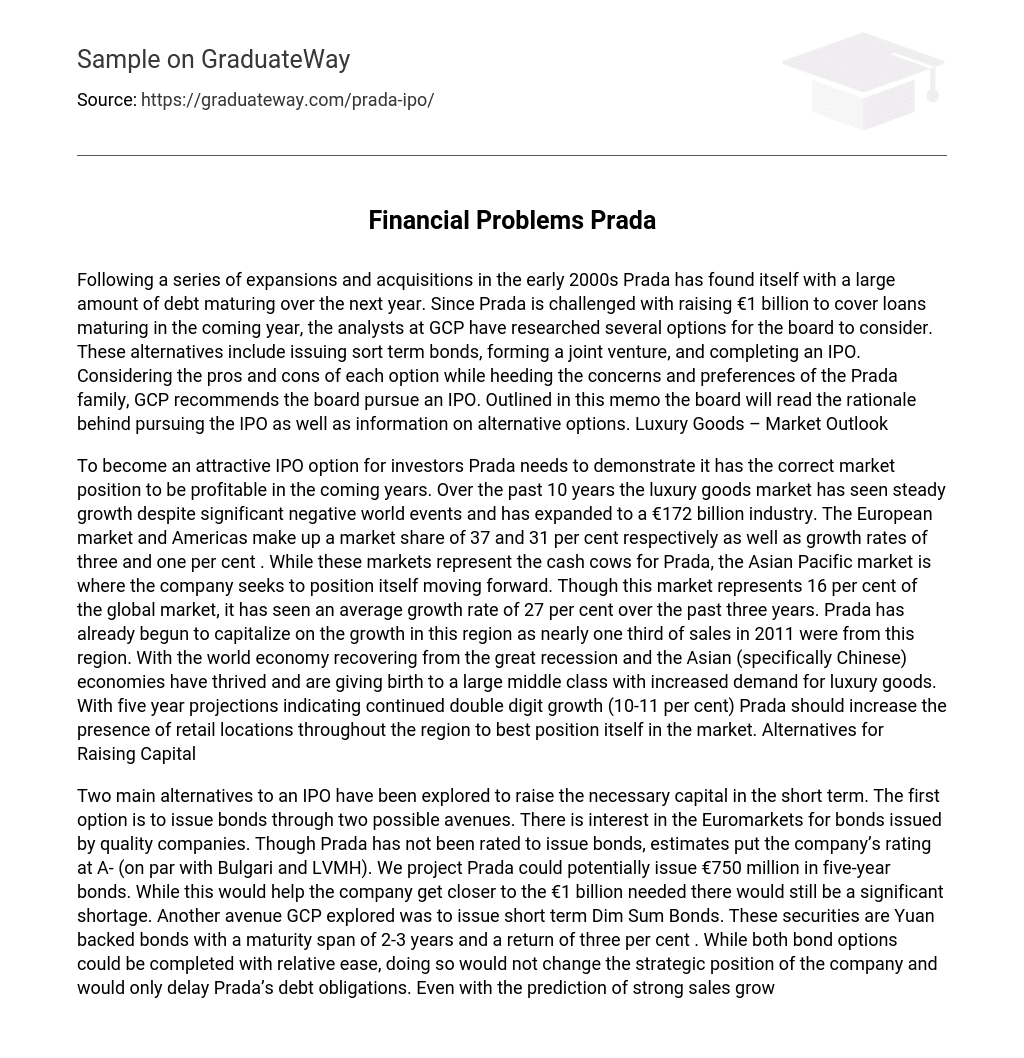Prada is currently facing a significant amount of debt that will mature in the near future due to previous expansions and acquisitions in the early 2000s. To address this challenge, the analysts at GCP have conducted research on various alternatives for the board to consider, such as issuing short-term bonds, establishing a joint venture, or conducting an IPO. After carefully evaluating the advantages and disadvantages of each option and taking into account the concerns and preferences of the Prada family, GCP recommends that the board move forward with an IPO. This memo outlines the rationale behind pursuing an IPO and provides information on the alternative options. Furthermore, it discusses the market outlook for luxury goods.
To attract investors, Prada must demonstrate its future profitability in the market. Despite negative global events, the luxury goods market has consistently grown in value over the past decade and is currently worth €172 billion. Europe accounts for 37% of this market, while the Americas account for 31%, with growth rates of three and one percent respectively. Although these markets are currently generating most of Prada’s income, the company aims to establish itself in the Asian Pacific market, which represents only 16% of the global market but has experienced an impressive growth rate of 27% over the past three years. In fact, Asia-Pacific accounted for nearly one third of Prada’s sales in 2011. The global economy is rebounding from recession, particularly in Asian economies like China that are thriving and creating a large middle class with an increasing demand for luxury goods. Projections indicate that this region will continue to experience double-digit growth (10-11%) over the next five years, making it advantageous for Prada to expand its retail presence there and secure a strong position within the market. Additionally, there are other options available for raising capital.
Instead of opting for an initial public offering (IPO), Prada is considering two alternatives to raise the necessary capital in the short term. The first alternative involves issuing bonds through two potential channels. The Euromarkets have shown interest in bonds issued by reputable companies, but Prada has yet to receive a rating for bond issuance. However, estimations indicate that Prada’s rating would be similar to Bulgari and LVMH at A-. It is projected that Prada could potentially issue €750 million in five-year bonds, bringing them closer to the required €1 billion, but there would still be a significant shortfall.
GCP is exploring another option which involves issuing short-term Dim Sum Bonds. These bonds are Yuan-backed with a maturity span of 2-3 years and offer a three percent return. While both bond options can be easily executed, choosing either one would not alter the company’s strategic position; it would only delay Prada’s debt obligations.
Despite strong sales growth predictions in the Asia-Pacific market, it would be prudent for Prada to settle its debts as soon as possible.
The alternative approach to raising capital involves forming a joint partnership with a private equity firm. Prada has previous experience collaborating with private equity groups and has even received enticing offers that offer a significant premium for the family’s controlling stake. Nevertheless, choosing this path would contradict the family’s intention to maintain control over the company, which is not in line with the overall objective of raising capital. Factors such as preferred capital sources, issuance country, and investors’ preferences are taken into consideration.
GCP has determined that Hong Kong would be the ideal location for Prada’s initial public offering (IPO) based on initial research. This is because the company would receive a higher valuation compared to going public in Europe. Despite the higher trading costs, investors are still drawn to this market as demonstrated by L’Occitane International, whose IPO was listed in Hong Kong and currently sees its stock trading at 45 percent above the initial price. Additionally, Hong Kong offers the advantage of low tax status with no capital gains tax imposed. However, Italy’s high tax rate of 27 percent on dividends paid to foreign investors may impact the traditional issuance process of the IPO. To make it more appealing, it is recommended that Prada considers a primary listing in Milan and provides a Hong Kong depositary receipt for Asian investors. Doing so would help minimize transaction costs for foreign investors.
Despite initial concern from the Prada family about losing control of the company through an IPO, it is actually the most prudent choice for raising the necessary capital while also allowing the family to maintain a controlling stake. This can be seen in exhibit A, which shows that the IPO would only require selling 20% of the available stock to raise the €1 billion capital needed. The family can then use their existing equity in the company to purchase the remaining 80% (or a percentage they deem appropriate) and retain control over Prada. Going public not only provides the capital to repay Prada’s debts but also offers a means to raise funds for expanding into the Asian-Pacific market without incurring significant debt again. Exhibit A





